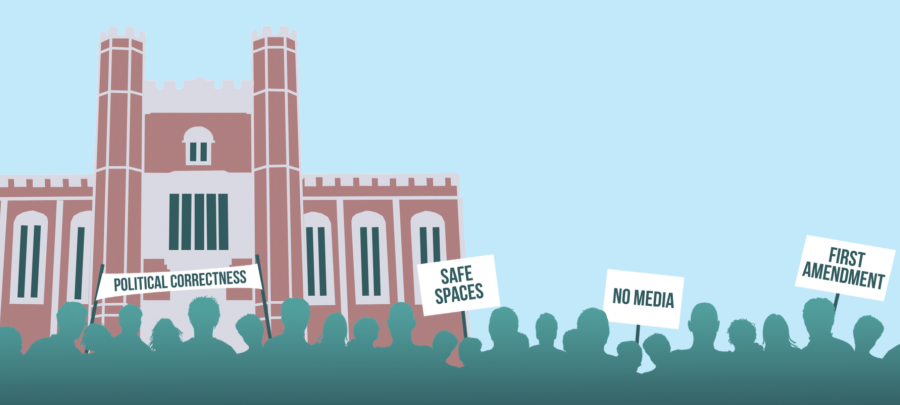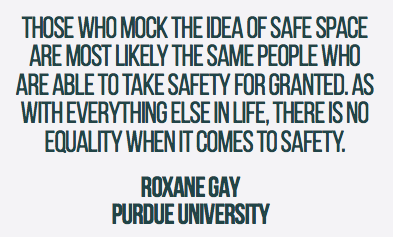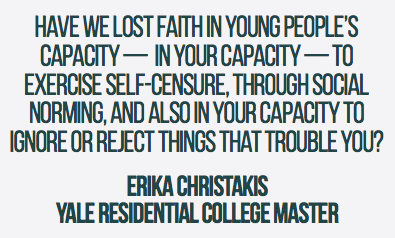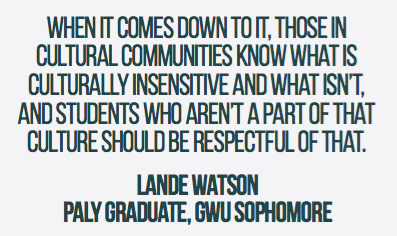Your donation will support the student journalists of Palo Alto High School's newspaper
At the crossroads of free speech and safety
The heated controversy over restricting offensive speech at colleges in favor of eliminating the threat of racial discrimination
December 11, 2015
A CALL TO ACTION
“There will never be a n— in SAE, there will never be a n— in SAE, you can hang him from a tree but he can never sign with me, there will never be a n— in SAE,” went the twisted parody of “If You’re Happy and You Know It.”
A video depicting members of the University of Oklahoma’s (OU) chapter of the Sigma Alpha Epsilon (SAE) fraternity repeatedly shouting racial slurs surfaced in May 2015, igniting controversy and drawing the attention of national media.
In response to the racist act, the OU football team refused to attend practice. Since the incident, OU administrators have taken action by suspending the SAE chapter at OU and expelling the students involved in the incident.
OU is not alone in facing struggles over the restriction of speech; racial tensions have been pervasive in universities around the country, and academic institutions of all levels have begun taking steps in order to promote equality and foster a sense of cultural sensitivity even if that means impinging on free speech. While the First Amendment protects freedom of speech in the United States as a mechanism of democracy, at times, the very same amendment allows for harmful microaggressions in communities nationwide that lead to certain groups feeling marginalized.
JEOPARDIZING STUDENT COMFORT
Proponents of free speech restriction point to the urgent concern of having total equality at all university campuses, arguing that the collegiate playing field must be leveled for students of all backgrounds. Likewise, programs such as affirmative action and financial aid were introduced to universities during the 20th century, as ways of bridging gaps between students of different races and socioeconomic backgrounds. The aim of these programs is fundamentally undermined by the notion of unrestricted speech: complete uncensored speech allows for the existence of racially intolerant or insensitive rhetoric on campus, which many students from minority or non-affluent backgrounds can find offensive and demeaning.
Recently, many American universities have been part of a widespread debate over what the role of administrators and faculty should be in the regulation of speech — an anomaly that finds most students favoring the authoritative power of universities — previously viewed by minority groups as oppressive and biased.
On Oct. 28 at Yale University, Nicholas and Erika Christakis, masters of the school’s Silliman College, wrote an email addressed to students calling for student self-discretion in choosing appropriate, inoffensive Halloween costumes and suggesting that students be thin-skinned in reacting to Halloween costumes. The suggestion received severe backlash from Yale students, who demanded university-led censure rather than a more laissez-faire, student-initiative based social policy.
“In your position as a master, it is your job to create a place of comfort and home for the students who live in Silliman,” a Yale student protested. “You have not done that… [Being a master] is not about creating an intellectual space! It’s about creating a home here!”
The Christakises, who also both lecture at Yale, have taken leave of the college for the remainder of the semester.
The student’s impassioned criticism reflects the views of many other students at Yale, including current Yale student and 2013 Paly graduate Julian Hornik.
“Where the line was drawn was that this was not [Christakis] utilizing her voice as a professor or intellectual,” Hornik said. “Her role in the college, which people outside of Yale have a hard time grasping, is as a figurehead in a dorm; she’s supposed to be a figure of hope for people.”
According to Hornik, the Christakis email violated that code of trust.
“When she sent out emails to her college, the sense was that this was person was saying ‘you know you’ll get over it,’ which was insensitive to [students of color],” Hornik said.
Hornik further noted that the student outcry at Yale over the Christakis email was motivated primarily by a call for help rather than by criticism.
“The part that people are perceiving incorrectly is that it wasn’t about intellectual freedom — we have plenty of that — this is about when someone in your own home is voicing something that has the potential to marginalize people within that home,” Hornik said.
Persons advocating for limited speech noted that their efforts were highly popular because they were entirely student-led.
One such advocate is the dean of Yale College, Jonathan Holloway, who encouraged student advocacy against uncensored speech in a Nov. 5 email addressed to the student body.
“Remember that Yale belongs to all of you, and you all deserve the right to enjoy the good of this place, without worry, without threats, and without intimidation,” Holloway wrote.
One-third of Yale’s undergraduate student body is from minority groups, and many seek the protection of their university in order to feel comfortable and thrive in a supportive learning environment.
“The idea that freedom of speech is being limited on campus is in a similar vein of rebranding as something like the gay marriage issue being twisted as the freedom of religion issue,” Hornik said. “One thing is not being excluded over the other; it’s letting all voices be heard.”
Roxane Gay, a professor at Purdue University, explained the need for administrative involvement in speech regulation as a system for helping minority groups in her Nov. 13 opinion, “The Seduction of Safety, on Campus and Beyond,” published in The New York Times.
“I am now always searching for safety, and I appreciate safe spaces — the ones I create for my students in a classroom, the ones I create with my writing and the ones others create, too — because there is so much unsafe space in this world,” Gay wrote.
In her piece highlighting the controversial events at Yale, Gay emphasized the need for such safe spaces as completely anti-discriminatory havens, wherein students could physically go in order to escape any remarks they might find hurtful.
“When you are marginalized and always unsafe, your skin thins, leaving your blood and bone exposed,” Gay wrote.
The crux of Gay’s argument is that non-minority Caucasians are desensitized to racism, and simply cannot recognize what many minority groups would see as a discriminatory or offensive remark.
“Those who mock the idea of safe space are most likely the same people who are able to take safety for granted,” Gay wrote. “As with everything else in life, there is no equality when it comes to safety.”
An undeniably important aspect of the free speech debate is that it is not exclusive to Yale; other universities such as the University of Missouri (Mizzou), Lewis and Clark College, University of Louisville, UCLA and Amherst College, have all seen student-led protests over restriction of speech in the past six months.
Like Holloway, many backers of student-led efforts for administration to censor speech make the point that, in the eyes of the law, university students are adults and should thus be able to responsibly lobby for speech restriction and further build an on-campus community wherein students feel comfortable. Though peppered with obscenities, the Yale student’s criticism of the Christakis email is seen by Holloway and proponents of restriction as mature adults’ pleas for a conducive learning environment.
WEAPONIZING SAFE SPACES
While discrimination and inequality are undoubtedly present everywhere, some journalists have noted that the fight to prevent it has recently come at the sacrifice of free speech. In several instances, many have argued that protesters have gone much too far with their actions. Journalists have explained that a significant part of the problem is that students have begun criticizing the wrong crowd — the very people who are trying to work together with the students to create an anti-discriminatory atmosphere.
The students at Yale have been blaming administrators for denying the existence of structural racism on campus, but this line of argument itself can be seen as flawed. According to Conor Friedersdorf, staff writer at The Atlantic, the Christakis email does not suggest that racism is not a problem, but rather argues that setting societal norms through expressions of free speech is the most effective method in truly eliminating racial discrimination. Christakis also believes that having higher powers such as administrators create a so-called “safe space” that in reality is just a facade hiding the real issues.
Hundreds of Yale protesters have signed an open letter to Christakis criticizing her tolerance of a potentially dangerous and prejudiced community.
“In your email, you ask students to ‘look away’ if costumes are offensive, as if the degradation of our cultures and people, and the violence that grows out of it is something that we can ignore,” Yale students wrote. “We were told to meet the offensive parties head on, without suggesting any modes or means to facilitate these discussions to promote understanding.”
The students argue for a “means to facilitate discussions” in their letter, but Christakis reasons that she has done nothing but support healthy discussion. Christakis explained in her email that prohibitions from authorities are ineffective and instead encourage the students to create their own thresholds for what is and is not acceptable by allowing for personal expression free from interference of administrators.
“American universities were once a safe space not only for maturation but also for a certain regressive, or even transgressive, experience; increasingly, it seems, they have become places of censure and prohibition,” Christakis wrote. “And the censure and prohibition come from above, not from yourselves! Are we all okay with this transfer of power? Have we lost faith in young people’s capacity — in your capacity — to exercise self-censure, through social norming, and also in your capacity to ignore or reject things that trouble you?”
The students go on to complain in their letter that the administrators have allowed perpetuation of the issue by encouraging offensive Halloween costumes.
“We are not asking to be coddled,” the students said. “The real coddling is telling the privileged majority on campus that they do not have to engage with the brutal pasts that are a part of the costumes they seek to wear.”
Friedersdorf believes that the premise on which the students base this reasoning also makes an unfair assumption — that the administrators find offensive costumes acceptable. However, Christakis makes it clear in her email that she is supportive of the battle against provocative costumes and acts, but that the battle must be fought by the students and not by authorities.
The Yale masters claim that their initial intent was to improve Yale communities, and while Christakis’s email raised several controversial issues, much of the general public believes that the students’ reactions to it have been overblown.
“Why the f— did you accept the position?” a Yale student screamed at Nicholas Christakis. “Who the f— hired you? You should step down! You should not sleep at night! You are disgusting!”
Friedersdorf sees irony in the Yale protests and explains that in an effort to ensure a safe space for themselves, the protesters have created a threatening space by personally attacking Nicholas Christakis, spitting on several other Yale students who were in agreement with Christakis and asking both Nicholas and Erika Christakis to resign their roles at Silliman.
Despite this accosting, the Christakis couple has invited the students of Silliman College to continue a civil discussion in their campus home. Many appreciate this invitation, as it shows that the couple is open to discussion.
At Mizzou, a group of student activists, ConcernedStudent1950, has led numerous protests against the administration that resulted in the resignation of Mizzou President Timothy Wolfe and the outcry against racism nationwide.
On Nov. 10, Mizzou student photojournalist Tim Tai was on a freelance assignment for ESPN to capture the events of a gathering organized by ConcernedStudent1950. As he began to take photos, a group of students from the gathering obstructed his view and ability to take photos by waving their arms in front of Tai’s camera, claiming that they had a constitutional right to privacy.
“Hey hey, ho ho, reporters have got to go,” the students chanted.
Tai stood his ground and continued to take photos, insisting that he himself also had a right to be at the event as a journalist.
“The First Amendment protects your right to be here and mine,” Tai said.
The crowd eventually formed a wall and began to walk forward, attempting to push Tai out of the event. Tai made no attempt to fight back, and continued to explain that his right to take photos was defended under the Constitution.
A video of the incident was uploaded to social media by another journalist, Mark Schierbecker, who at the end of the video appeared to also have encountered physical harassment. Melissa Click, assistant professor of mass media at the Missouri School of Journalism, grabbed at Schierbecker’s video camera after he revealed his identity as a journalist.
“Who wants to help me get this reporter out of here?” Click yelled. “I need some muscle over here!”
After the video went viral, many fellow journalists as well as the general public applauded Tai’s maturity and defense of his First Amendment freedoms.
David Kurpius, the dean of Mizzou’s journalism school, was among the supporters, saying Tai “handled himself professionally and with poise.”
Meanwhile, Click has received enormous backlash over social media and even made appearances in several episodes of “South Park,” an adult animated sitcom known for its raunchy social commentary. Click apologized to both Tai and Schierbecker several days after the incident, but has continued to be heavily criticized.
“I regret the language and strategies I used, and sincerely apologize to the [Mizzou] campus community, and journalists at large, for my behavior, and also for the way my actions have shifted attention away from the students’ campaign for justice,” Click said.
Tai claims that he had no malicious intent in capturing the event, explaining that he planned to use these photos to allow others across the nation understand the racist incidents that minority groups at Mizzou have had to battle.
“We’re documenting historic events with our photographs, and when people are crying and hugging when Wolfe resigns, it becomes a personal issue that people all over the country can connect with,” Tai said. “It’s my job to help connect those people to what’s going on.”
Creating a safe space on any campus is valuable, but it has been argued that protesters have not taken the right approach at universities like Yale and Mizzou.
“In the video of Tim Tai trying to carry out his ESPN assignment, I see the most vivid example yet of activists twisting the concept of “safe space” in a most confounding way,” Friedersdorf wrote. “They have one lone student surrounded. They’re forcibly preventing him from exercising a civil right. At various points, they intimidate him. Ultimately, they physically push him. But all the while, they are operating on the premise, or carrying on the pretense, that he is making them unsafe. It is as if they’ve weaponized the concept of safe spaces.”
Friedersdorf also argues in another article that while free speech has the potential to allow offensive language, it preserves the tools necessary to struggle against racism.
“To me, it is bizarre that the same campus activists who declare their institutions and the United States to be rooted in white supremacy and hostile to students of color want to empower the very authorities in charge to punish speech at their discretion!” Friedersdorf wrote.
Friedersdorf goes on to explain that while declaring the First Amendment null when it interferes with racist speech seems compassionate towards marginalized groups, it harms them in the long run since it sets a precedent that could potentially restrict minority groups themselves from speaking up against oppressive structures.
Friedersdorf, White and other critics of excessive student activists believe that rather than produce a threatening environment, especially to those who claim to be decrying social injustice, protesters should reevaluate their actions and make sure that they are protesting to and against the right crowds.
PALY’S PERSPECTIVE
The primary public issue of free speech at universities ties directly into a growing American movement of political correctness. Princeton University has recently debated whether to remove President Woodrow Wilson’s name and image from its public spaces and the Woodrow Wilson School of Public and International Affairs due to Wilson’s support for racial segregation. Georgetown University has had similar discussions over Mulledy Hall and McSherry Hall, both of which are named after school administrators who encouraged slavery.
But the issue is not limited to universities — Palo Alto residents have recently petitioned for the renaming of David Starr Jordan Middle School for similar reasons. Jordan was the founding president of Stanford University, but also argued for the superiority of whites over other races in his series of publications entitled “The Blood of the Nation.” Some community members feel that Jordan’s advocacy of eugenics is not representative of Palo Alto’s values, and thus his name should be removed from what is currently Jordan Middle School.
“I’m really looking forward to the dialogue — I’m really keeping an open mind right now,” Palo Alto Unified School District (PAUSD) Superintendent Max McGee said. “I’m really interested in hearing how the school got named in the first place. What are the different alternatives? What are the logistics and the financial ramifications? What other unintended consequences are there? I think it’s a really fascinating conversation.”
This instance of endorsing an individual with racist views is comparable to what has been happening at Princeton and Georgetown, even Paly campus is not safe from racial marginalization.
“Everyone has their conscious or unconscious prejudices, and needs to learn how to unpack and address them,” 2013 Paly graduate and current Vanderbilt University junior Yoko Kanai said. “So yeah, I see racism everywhere, even Paly.”
At Paly, racism primarily takes form in microaggressions, or acute hostilities. Although the magnitude of the offenses that occur on campus may not be quite as severe, as elsewhere, they still perpetuate an overall environment of marginalization within the community.
“I haven’t seen anything as drastic as what’s been going on at these colleges,” senior Gideon Kortenhoven said. “Little things happen, but that happens everywhere. But I think Paly does a good job. I don’t know many people who are super disrespectful, but that’s not to say that there aren’t still people who are unconsciously offensive.”
Kortenhoven is involved in Paly’s Black Student Union (BSU), a student club which meets weekly to discuss issues of racism on campus and the broader community.
“In BSU, we talked about microaggressions and people shared some of their experiences with microaggressions,” Kortenhoven said. “I think that BSU is really positive — anyone can say anything they feel in BSU. I wish more people would take advantage of the opportunity, because it’s a place where you can talk about anything.”
Besides forming organizations such as BSU to promote the cultural interests of marginalized communities and create safe spaces for individuals, PAUSD has taken steps to prevent the harms of racism that have potential to expand.
“One of the key problems that last year’s Minority Achievement Talent Development Committee identified was an unconscious narrative of bias,” McGee said. “Over the next two years, every single employee will go through two consecutive days of unconscious bias training. I think it’s going to make a difference — it certainly did for a lot of the people I’ve talked to that have gone through it already.”
This unconscious bias is a problem that communities have struggled with for a long time. 2014 Paly graduate and George Washington University sophomore Lande Watson believes that both administrators and students should play a role in exposing these biases and creating norms within the community to weed out unhealthy behavior.
“[Administrators] should ensure that students aren’t threatened because they’re attempting to have a discussion about racism and cultural sensitivity,” Watson said. “I agree that the onus is mainly on students to facilitate these discussions, but the administrators have a responsibility to students of color to create and maintain a safe environment.”
Defining the threshold for what is culturally insensitive is difficult, especially given that different groups of people have dissenting opinions on what that threshold is. However, most agree that it is important to be respectful of people of other cultures and not violate their individualities.
“When it comes down to it, those in cultural communities know what is culturally insensitive and what isn’t, and students who aren’t a part of that culture should be respectful of that,” Watson said.
While administrators and students alike are faced with the difficult task of making everybody feel welcome, it is important for community members to understand that any discrimination that they may be facing is a battle fought by many others around them.
“My advice is that you are never alone in your experiences of marginalization,” Kanai said. “You can find people who have got your back.”
Indeed, it seems that a more culturally sensitive ideology has emerged at universities, in keeping with a newer American movement of political correctness. As universities have begun reconsidering names of traditional buildings and even contemplating discrediting historical figures, it is clear that an increasingly acute viewpoint has emerged.
OUTCOME
As we continue to address the same issue of racial marginalization that has caused enormous strife in past centuries, many controversies remain unsettled. What is administration’s responsibility in resolving racial tensions? How can communities effectively communicate to reach consensuses on what is and is not acceptable?
When we reflect back on SAE’s incredibly racist chant, it is important to keep in mind two distinct schools of thought. Yes, the chant is undeniably offensive and marginalizing. Yet, is it not the quintessence of freedom of speech?




Eric Bloom • Dec 15, 2015 at 8:49 pm
yes, and http://www.huffingtonpost.com/2015/03/12/oklahoma-sae-first-amendment-racism_n_6856906.html
It is not as much a question of free speech as of civility and common decentcy, hopefully we can hold two ideas at the same idea–the right to free speech and the tact and grace to refrain from promoting racist and exclusionary views.